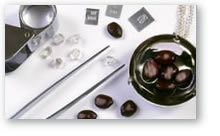No tool can cut a diamond, and even the hottest fire leaves no mark on it. This led many people to believe that diamonds possessed supernatural powers.
To the Greeks, diamonds were the tears of the gods. The Romans believed they were fragments of fallen stars. In India, diamonds were seen as lucky charms that protected against illness, theft, and evil. Other cultures attributed healing and wisdom-granting properties to them.
Legends and myths surrounding diamonds made them highly desirable. Ancient kings wore diamonds in battle, while queens and noblewomen coveted them as symbols of power and passion.
Being unique, precious, and indestructible, diamonds have symbolized love for centuries. Today, the tradition of giving a diamond ring as a symbol of love and commitment is widespread across cultures worldwide.
No other gemstone captures emotions and life’s significant moments as perfectly as a diamond.
Giving or receiving a diamond enhances the importance of life’s special moments: the birth of a child, an anniversary, a birthday, a personal achievement, or simply a self-reward.
Whatever the occasion, celebrating it with a diamond makes it unforgettable. After all, a diamond is a piece of eternity.
Each diamond is unique—no two are exactly alike.
Buying a diamond is a special experience, as it is a miracle of nature that has existed since the dawn of time.
Thanks to nature’s variety, there is always a diamond that suits your taste, budget, and special occasion.
The diamond you choose represents one of life’s deepest emotional investments. It will be passed down through generations, valued not only for its material worth but also for its sentimental significance.
Regardless of its position on the 4C scale (cut, color, clarity, and carat weight), once you own a diamond, it becomes a special gem whose true value lies in its symbolism and the occasion it commemorates.
A brand is a unique name that distinguishes specific products and services from others. The best way to ensure you are purchasing a high-quality product is to choose a branded one. A brand guarantees the trust and comfort consumers seek in their purchasing experience.
When it comes to diamond jewelry, branding is even more important. Emphasizing the significance of a branded diamond with the slogan "Whispering the Name of Diamond," Zen Diamond ensures that all its products bear the Zen Diamond signature and are accompanied by an International Diamond Quality Certificate. In Turkey, the name "diamond" is synonymous with Zen Diamond.
Every diamond is incredibly ancient. Even the youngest diamonds are 900 million years old, while the oldest are over 3.2 billion years old—formed long before dinosaurs existed.
Diamond is the hardest natural material known to mankind, 58 times harder than the next hardest mineral on Earth.
Only another diamond can cut a diamond.
During cutting and polishing, a diamond loses more than half of its original weight.
Less than 5% of all diamonds used in jewelry are larger than one carat.
Diamonds can occur in any color, but the rarest color is red.
The largest gem-quality diamond ever discovered, the Cullinan Diamond, was found in South Africa in 1905. It originally weighed 3,106 carats—about the size of an ostrich egg.
The highest price ever paid per carat at a diamond auction was $1 million for a 0.95-carat purplish-red diamond.
If all the diamonds ever polished were collected, they would only fill a single double-decker bus.
The word "diamond" comes from the Greek word "adamas," meaning "unconquerable."
The word "carat" comes from the carob tree seed, which was used in ancient times as a standard for weighing gemstones.
The tradition of giving a diamond ring as a symbol of love and commitment began in the 15th century when Archduke Maximilian of Austria gave a diamond ring to Mary of Burgundy during their engagement. The tradition of wearing a ring on the fourth finger of the left hand originated from ancient Egyptians’ belief that the "vein of love" (vena amoris) ran directly from that finger to the heart.

